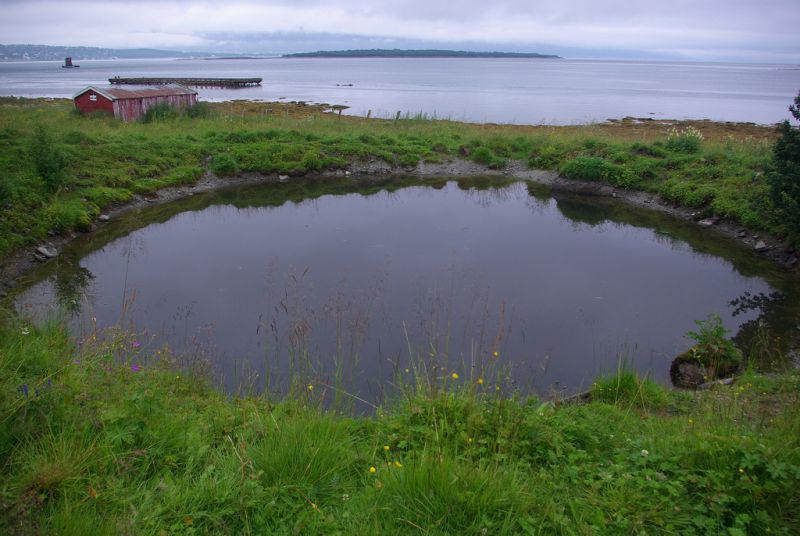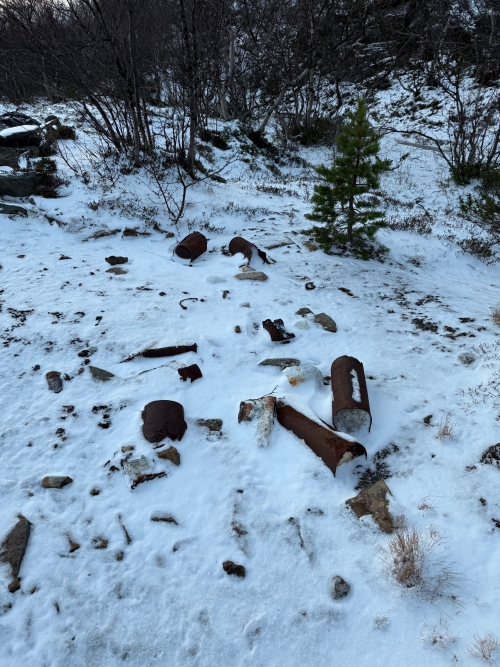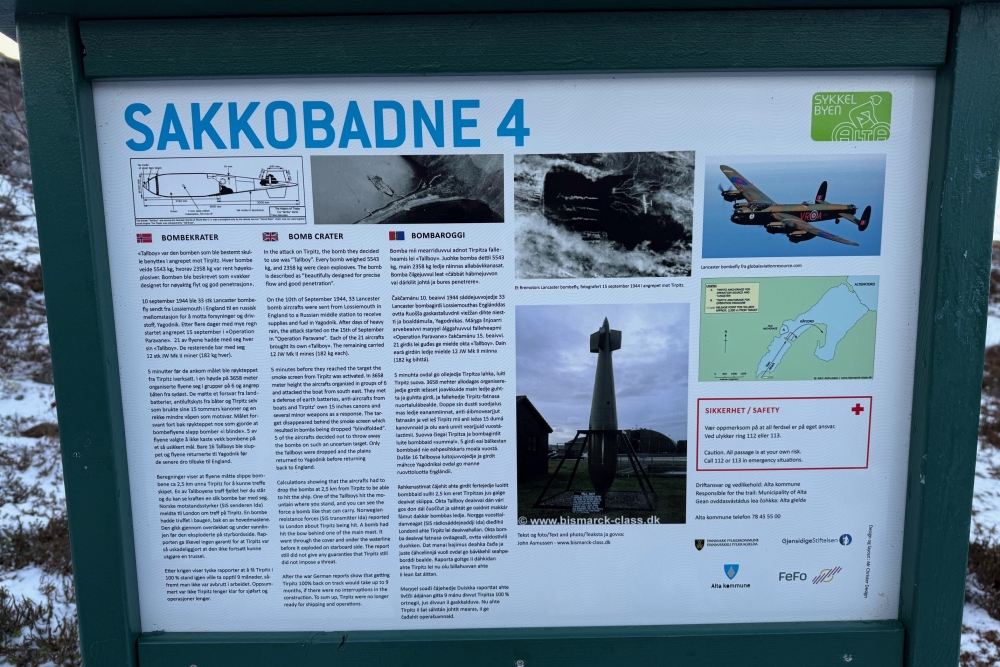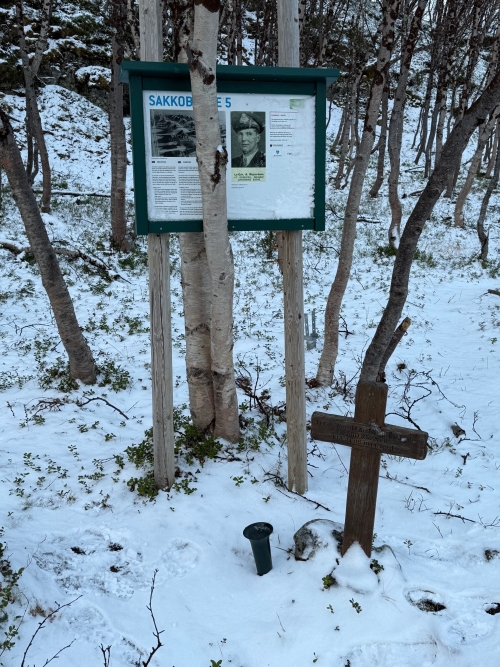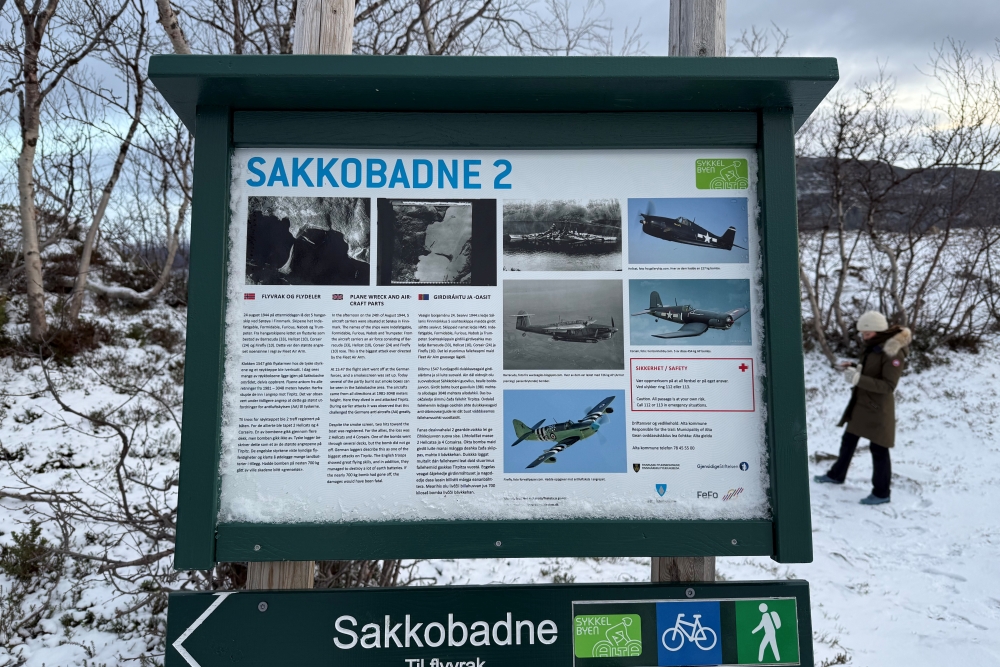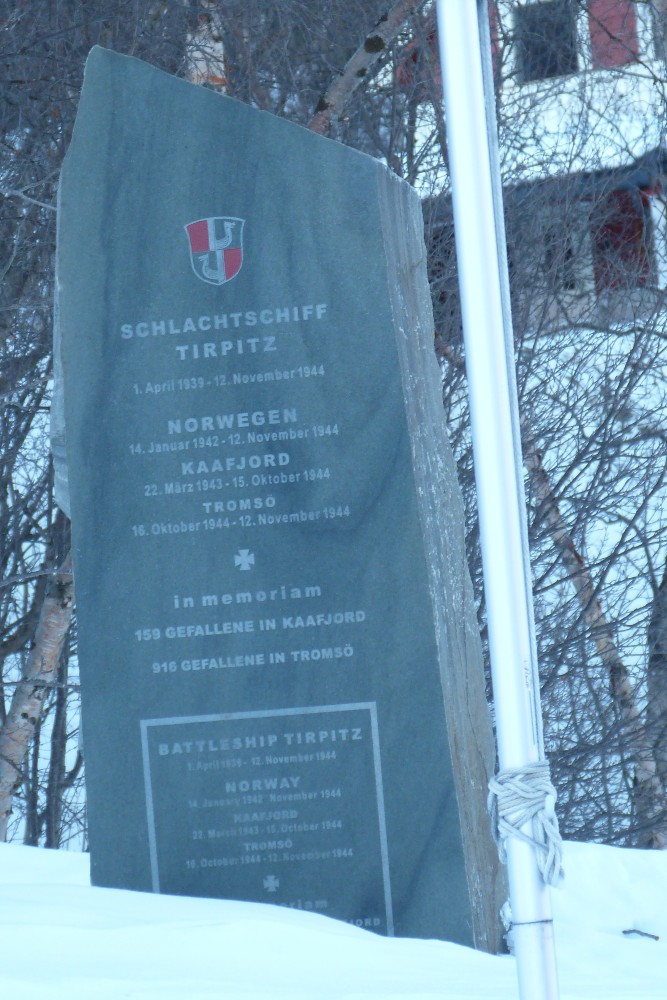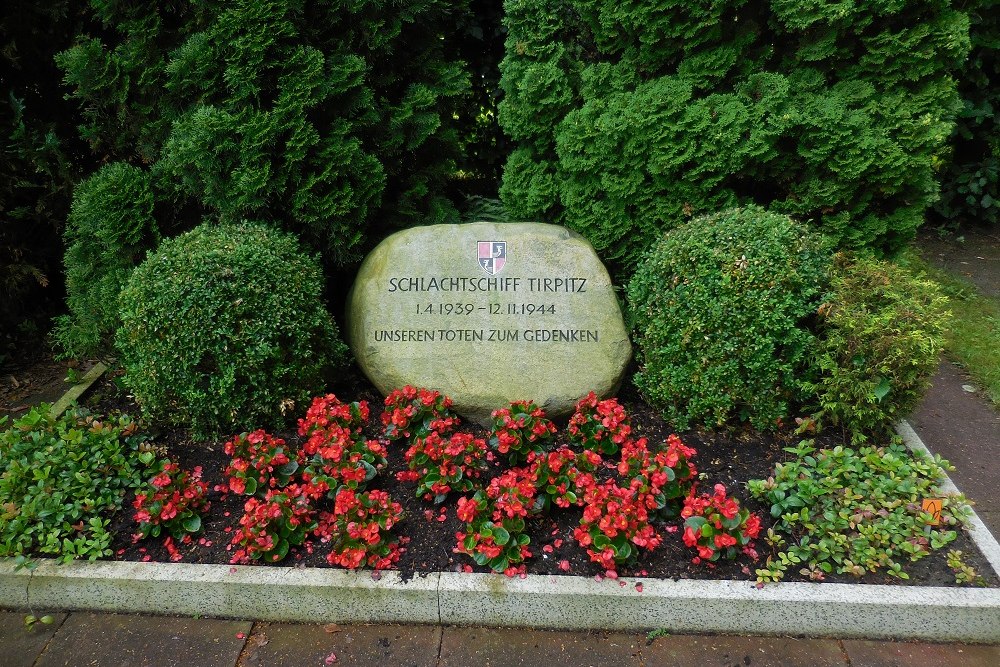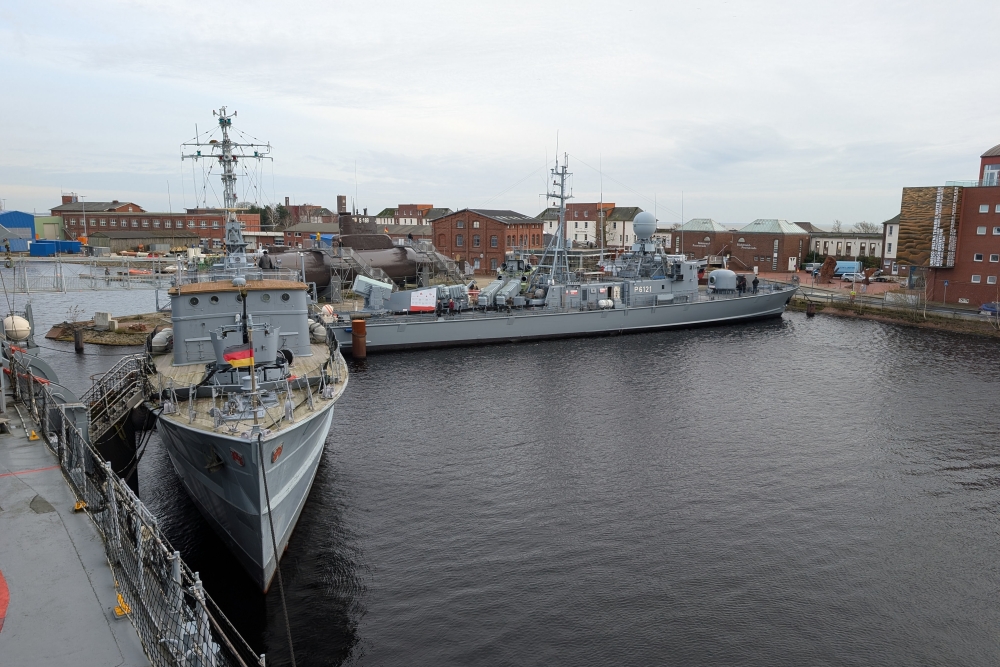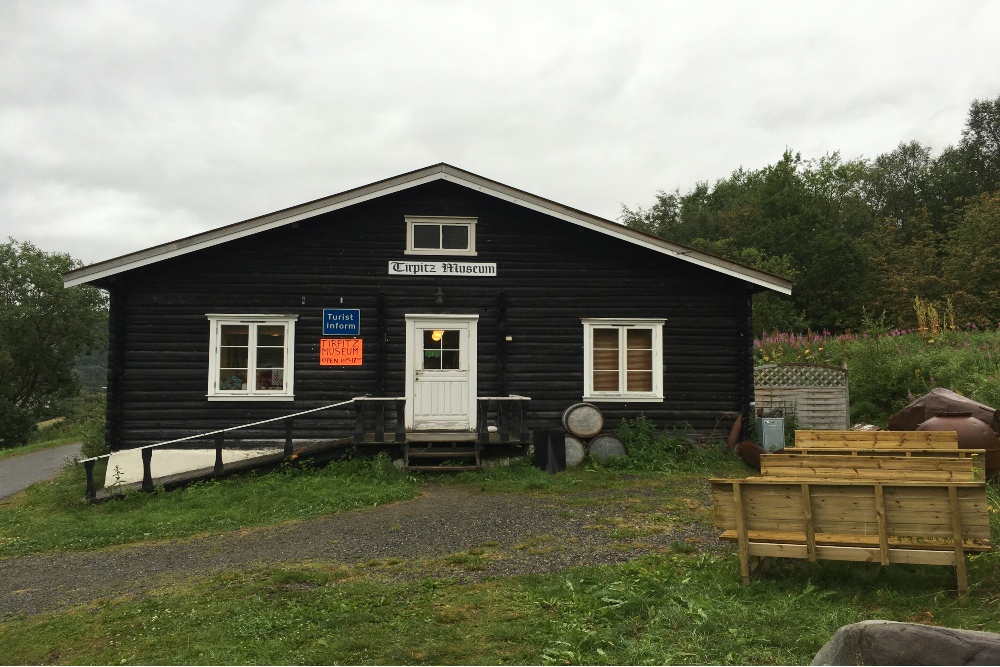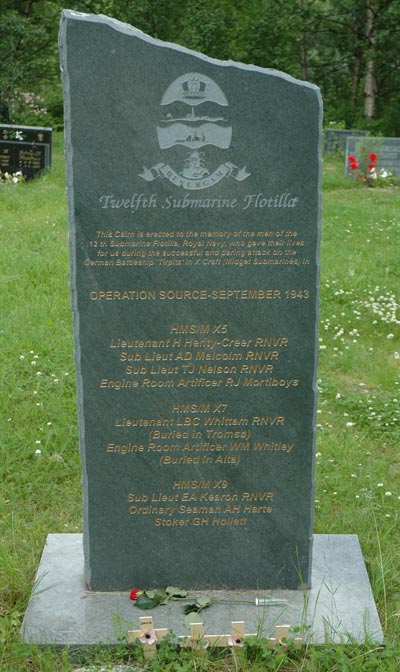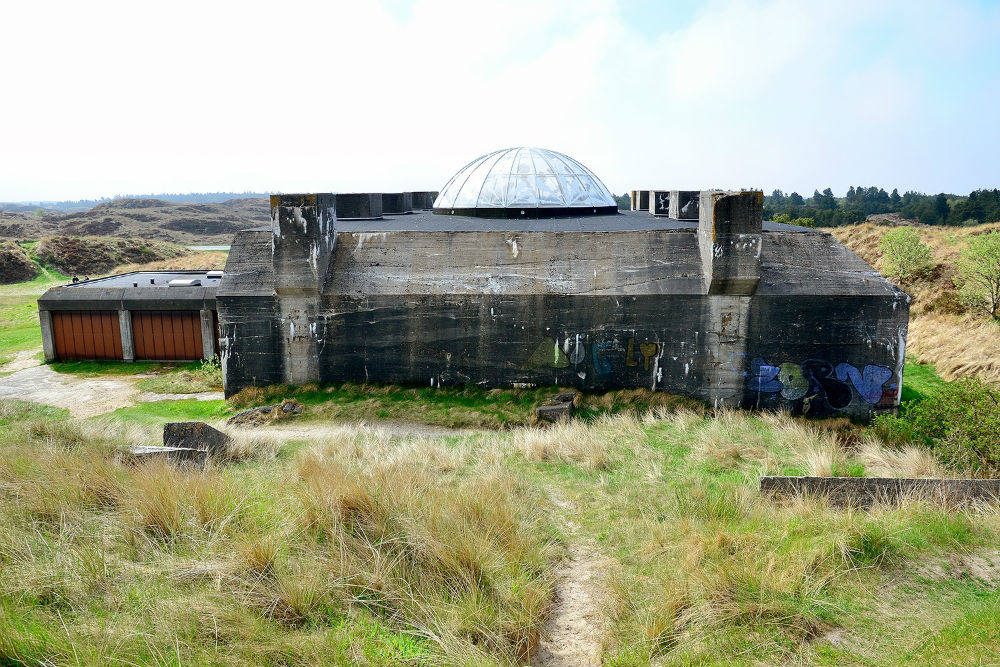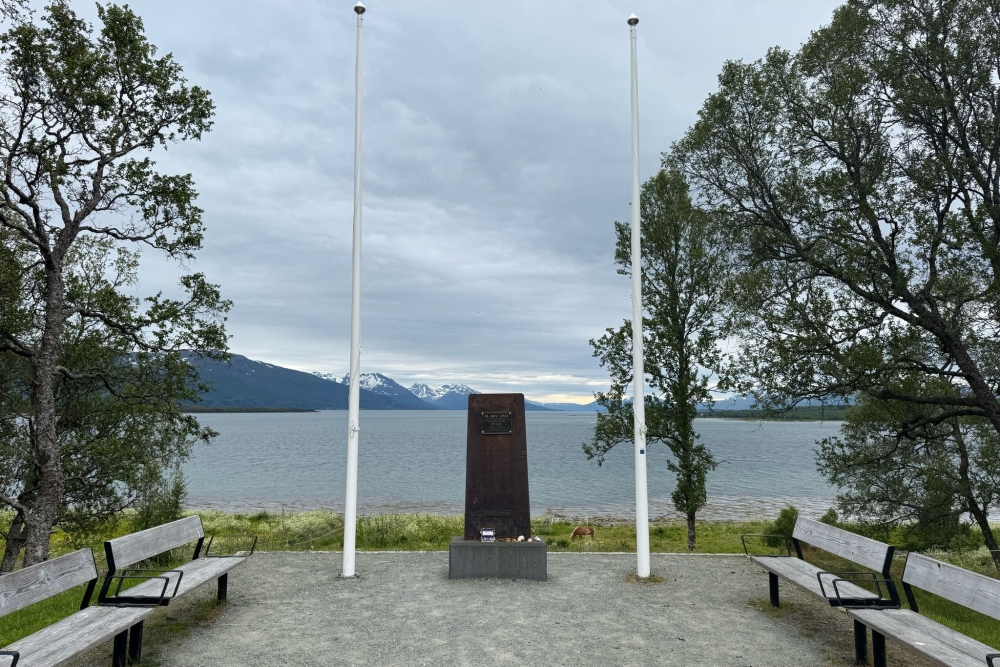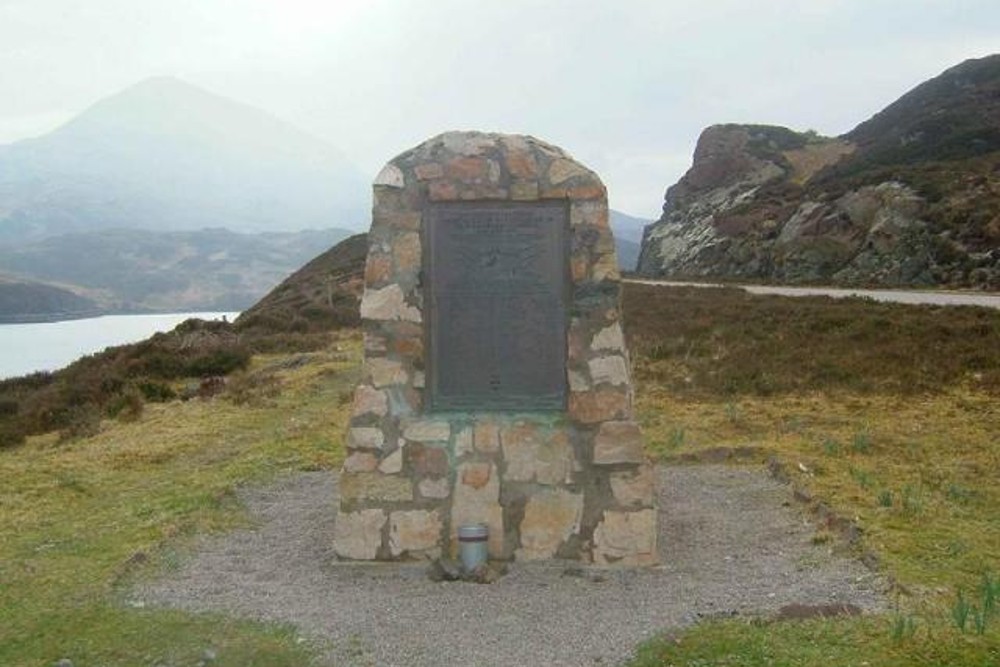Prologue
Tirpitz was the second Bismarck class battleship that was built for the Kriegsmarine. Her keel was laid, construction number 128, on November 2, 1936 at the Kriegsmarinewerft in Wilhelmshafen. The battleship was launched on April 1, 1939. Even before the new vessel was commissioned on February 25, 1941, the British launched 15 air raids with Handley Page Hampden and Vickers Wellington twin-engine bombers, directly aimed at the Tirpitz which was berthed in the final assembly dock in Wilhelmshafen. These aerial attacks, launched from British airfields caused minor damage to the vessel. Final assembly of the Tirpitz was only slightly delayed. After the vessel had been commissioned by her commander, Kapitän-zur-See Friedrich Karl Topp, and prior to her sea trials, the Tirpitz was targeted twice by British air raids which had just as little effect.
In September 1941, her sea trials were temporarily suspended as Tirpitz joined the Baltenflotte, the German Baltic Fleet. Early 1942, the Tirpitz was dispatched to Norway to pose as Fleet in Being and as such the battleship posed a threat to the Allied Arctic convoys sailing to and from the Soviet Union. In this way the Germans wanted to prevent the Tirpitz from suffering the same fate as her sister ship the Bismarck which had been hunted down and sunk in May 1941 by the Royal Navy. British attempts to eliminate the battleship proceeded relentlessly. Also at the end of March 1942, the only dry dock on the Atlantic coast large enough to accommodate the Tirpitz was destroyed as a precautionary measure by the British during Operation Chariot, the raid on Saint Nazaire. In Norway the big battleship was not only subjected to attacks from the air but also by human torpedoes and midget submarines.
Twice, Tirpitz participated in direct German efforts to attack convoys and in September 1943, she took part in the German attack aimed at Spitsbergen, a group of Norwegian islands in the north Atlantic. The rest of the time, Tirpitz lay camouflaged in Norwegian fjords. At the time, The Norwegians called her the Lonely Queen of the North. British attacks grew in intensity as the mere presence of the battleship posed a perennial threat. Winston Churchill considered knocking the Tirpitz out one of his major priorities. British bombs had little effect on the heavily armored battleship though until the R.A.F. started using the so-called Tallboys, 12,000 lbs bombs designed to penetrate deeply into the ground, into concrete or into armored steel decks of ships.
On September 15, 1944, Tirpitz' forecastle was struck by two Tallboys and from then on she was no longer seaworthy. The vessel was transferred to the small island of Håkøy near Tromsø in order to serve as a floating artillery emplacement. The ship now was well within reach of AVRO Lancaster bombers flying from Scotland. 31 of these long-range bombers attacked the battleship on November 12, 1944 and two direct hits and a few near misses of Tallboys sealed the fate of the battleship forever. Tirpitz capsized and nearly 1,000 crewmembers lost their lives. It would take until 1957 before the wreck was dismantled.
Definitielijst
- battleship
- Heavily armoured warship with very heavy artillery.
- Fleet in Being
- A war fleet preventing battle but by its presence and force forcing the enemy to take measures by allocating forces to keep an eye on them thus preventing those forces from being deployed elsewhere.
- Kriegsmarine
- Germa navy. Part of the Wehrmacht next to Heer and Luftwaffe.
- raid
- Fast military raid in enemy territory
- Soviet Union
- Soviet Russia, alternative name for the USSR.
Images
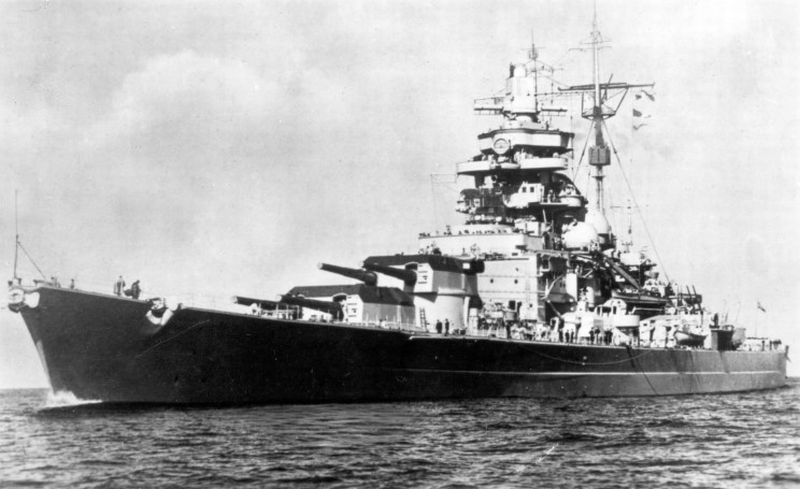 Tirpitz on a trial run in the Baltic in the summer of 1941 Source: Courtesy of Michael W. Pocock.
Tirpitz on a trial run in the Baltic in the summer of 1941 Source: Courtesy of Michael W. Pocock.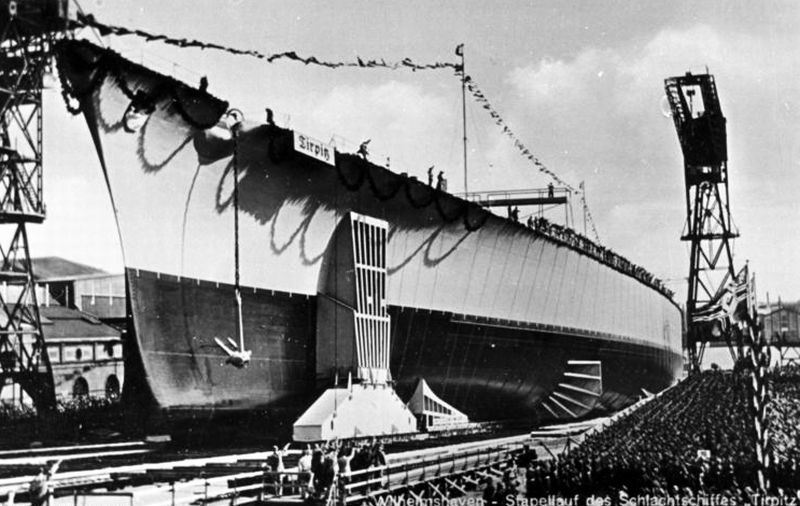 Launch of the Tirpitz, April 1, 1939 Source: Bundesarchiv, DVM 10 Bild-23-63-40 / CC-BY-SA 3.0.
Launch of the Tirpitz, April 1, 1939 Source: Bundesarchiv, DVM 10 Bild-23-63-40 / CC-BY-SA 3.0.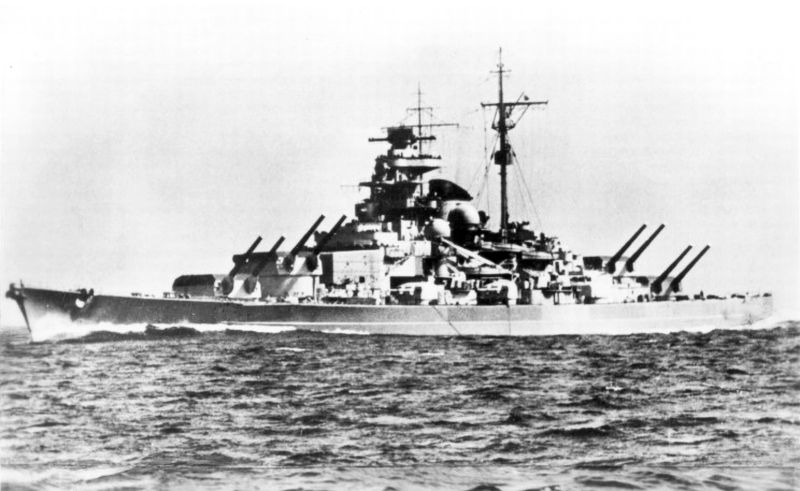 Tirpitz aiming her main armament during trials in 1941 Source: Courtesy of Michael W. Pocock.
Tirpitz aiming her main armament during trials in 1941 Source: Courtesy of Michael W. Pocock.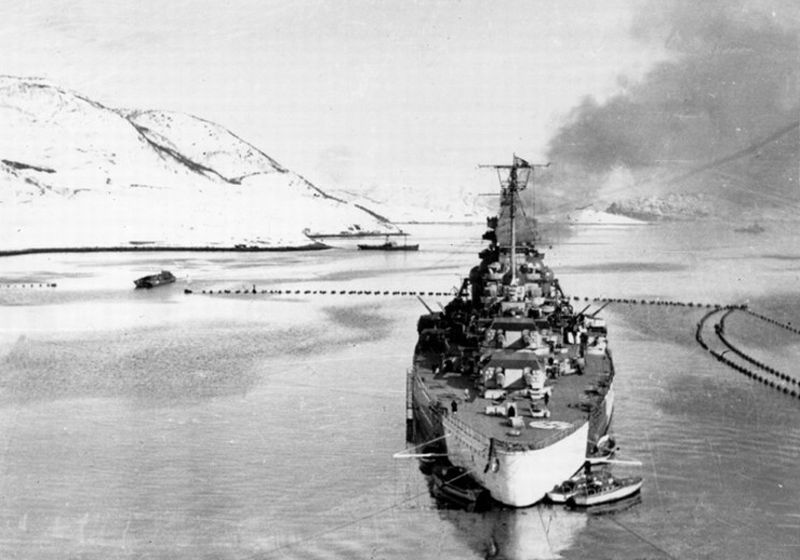 The Lonely Queen of the North in the Altafjord Source: Courtesy of Michael W. Pocock.
The Lonely Queen of the North in the Altafjord Source: Courtesy of Michael W. Pocock.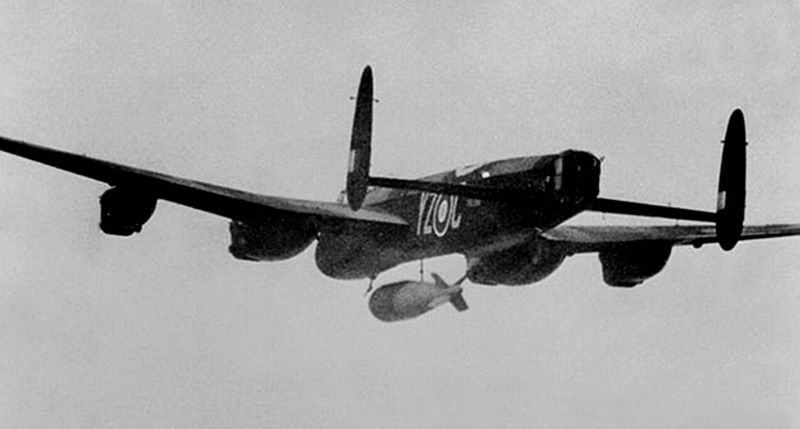 An AVRO Lancaster dropping a Tallboy Source: Ausairpower.
An AVRO Lancaster dropping a Tallboy Source: Ausairpower.To Norway
After the Tirpitz had been commissioned, a period of sea trials and training of the 2,065 crew members began in the Baltic. Adolf Hitler paid a visit to the two Bismarck class vessels Bismarck and Tirpitz in former Gdynia, the city on the Baltic Sea which had been captured by the Germans and renamed Gothenhafen. May 16, Bismarck set sail for Operation Rheinübung (Rhine training) accompanied by the heavy cruiser Prinz Eugen. It was intended that both major warships should attack Allied convoys in the Atlantic. From that moment on, engaging and destroying Bismarck was the highest priority for the British Home Fleet. Although the German battleship managed to sink the British battle cruiser H.M.S. Hood in the Strait of Denmark between Iceland and Canada, she was sunk by an overwhelming British force on May 27, 1941.
Tirpitz continued her trials which were suspended however in September 1941 when she became the flagship of the temporary Baltic Fleet. Apart from Tirpitz, this fleet consisted of the heavy cruiser Admiral Scheer, the light cruisers Köln, Nürnberg, Leipzig and Emden, a number of destroyers and two flotillas of minesweepers. The squadron was to prevent the Soviet Baltic Fleet from breaking out of its base in Kronstadt near Leningrad. To this end, the German squadron patrolled off the Aland islands between September 23 and 26. After it dawned on the Germans the Soviet fleet was not going to stir, the Baltic Fleet was disbanded and Tirpitz resumed her trials. During this period, the primary and secondary armament of Tirpitz was extensively tested and target practice was conducted. For these exercises, the aged battleship Hessen was used as a radio controlled target vessel.
On November 13, 1941, Großadmiral Erich Raeder, Commander-in-Chief of the German navy suggested to dispatch the Tirpitz to Norway in order to pose as Fleet in Being. Furthermore, this would enable the battleship to attack Allied convoys sailing to and from the Soviet Union from her base in occupied Norway. In this way, the British Home Fleet would mainly occupy itself with protecting the convoys and not be involved in a possible invasion in Norway. Hitler accepted Raeder's proposal as he had forbidden Tirpitz to venture out into the ocean after the loss of her sister ship the Bismarck.
In Kiel, Tirpitz was equipped with additional 20mm anti-aircraft guns; her 10.5cm guns, which could also be used in an anti-aircraft role, were mounted farther to the side resulting in a wider field of fire. Finally, the defensive and offensive measures were expanded by fitting 2 four-barreled torpedo tubes. On January 10, 1942, commander Topp declared his ship ready for action.
On January 12, 1942, Tirpitz sailed through the Nord-Ost Sea canal from Kiel to Wilhelmshafen, arriving 2 days later. There, the destroyers Z 4 Richard Beitzen, Z 5 Paul Jacobi, Z 8 Bruno Heinemann and Z 29 joined the battleship to escort her to Norway. On January 14, at 23:00 hours, the 5 German battleships set sail for Trondheim in Norway British military intelligence was aware of the departure of the battleship and her escorts because they were able to decipher the German Enigma code but due to adverse weather conditions, the R.A.F. could not take any action. On January 16, Tirpitz was spotted in Trondheim by a British aircraft. The same day, Tirpitz left for the Fjaettenfjord, a little north of Trondheim where she anchored in a sheltered location and was camouflaged. A number of anti-aircraft batteries were set up on the cliffs above the fjord and torpedo nets were rigged around the Tirpitz.
A fortnight later, R.A.F. Bomber Command launched Operation Oiled, the first aerial attack on the Tirpitz in Norway In the night of January 30 and 31, 1941, 7 Short Stirlings and 8 Handley Page Halifax four-engine bombers took off from R.A.F. Lossiemouth in Scotland. Owing to adverse weather conditions and the camouflage, the bombers could not find the German battleship and the operation ended in failure.
Between March 5 and 9, 1942, Tirpitz took part in Operation Sportpalast. The intention was an attack on the Allied convoy PQ-12, on its way from Iceland to Murmansk in the Soviet Union and convoy QP-8 on the return voyage. The battleship set sail on March 5 from the Fjaettenfjord, escorted by the destroyers Z 25, Z 14 Friedrich Ihn and Z 7 Hermann Schoemann under overall command of squadron commander Admiral Otto Ciliax. As the British were aware of the plans for the attack, they ordered the convoy to change course. Tirpitz and 3 destroyers detached themselves and searched two areas separately. On March 7, the German destroyers spotted the Russian merchantman Izhora of QP-8 which had fallen behind and sank her. Subsequently they retreated to base in Trondheim for lack of fuel. Tirpitz vainly searched for merchantmen for three days. Operation Sportpalast was aborted and Tirpitz steamed towards the Lofoten, a group of island west of Narvik. Just before the battleship had reached the cover of the Vestfjord near Bogen, between the Norwegian mainland and the Lofoten, she was attacked by 12 Fairey Albacore torpedo bombers from the carrier H.M.S. Victorious in the early morning of March 9 . Tirpitz had launched two of her Arado spotter planes to search for the enemy aircraft. During a dog fight, one of the British planes was damaged. Two Albacores were downed by anti-aircraft fire from the Tirpitz during the failed attempt. The British torpedoes failed to hit the Tirpitz or she could evade them. On March 13, Tirpitz safely returned to the Fjaettenfjord near Trondheim.
The German warships in Norway suffered from a chronic shortage of fuel and it took 3 months before they were ready for action against the Allied convoys. Over these 3 months, Tirpitz was attacked 3 times by Halifax and Lancaster bombers but owing to bad weather, all three attacks failed. The next target for the German was convoy PQ-17 which had been under way from Iceland to the Soviet Union since June 27. The convoy was escorted by the British battle cruiser H.M.S. Duke of York, the new American carrier U.S.S. Washington, the carrier H.M.S. Victorious and a number of destroyers. Tirpitz, the heavy cruiser Admiral Hipper, 5 destroyers and two torpedo boats left the Fjaettenfjord and the heavy cruisers Lützow and Admiral Scheer left the Bogenfjord near Narvik along with 6 destroyers. This attempt at sinking Allied merchantmen was called Operation Rösselsprung by the Germans. On July 1, Tirpitz and the other German war ships left in the direction of the convoy that had been spotted to the northwest of Norway. Lützow and 3 three destroyers were damaged however by collisions with cliffs that did not show on German sea charts and they had to return to Bogen. The movement of the German vessels had been noticed by British military intelligence and the British Admiralty considered the threat to a concentrated convoy of the Tirpitz so severe, it ordered the convoy to scatter and proceed to Murmansk on its own. This would prove a catastrophic mistake. Between July 2 and 5, 21 out of a total of 34 vessels in convoy PQ-17 were sunk by U-boats and Luftwaffe aircraft. The large German surface vessels were recalled to avoid an engagement with the escorting vessels of the convoy. Tirpitz arrived in Bogen near Narvik on July 6.
On October 23, 1942, Tirpitz returned to the Fjaettenfjord for maintenance. Hitler had not allowed the battleship to make the perilous passage to a port in Germany and the base in Trondheim was the only one in Norway with sufficient technical personnel at its disposal,. The defense of the mooring place in the fjord was expanded by a number of anti-aircraft batteries and a double steel net against torpedoes. In this period, the British and the Norwegian resistance attempted to attack the battleship using so-called Chariots, human torpedoes. The attack, code named Title failed because the fishing vessel Arthur, used by the Norwegian resistance to tow the Chariots, lost them because of bad weather. On December 28, maintenance work was completed and Tirpitz set sail for some trial runs. On February 21, 1943, Kapitän-zur-See Hans Meyer took over command of the battleship from Friedrich Karl Topp who had been promoted to Konteradmiral and was named chairman of the Schiffbaukomission des Reichsministers für Rüstung und Kriegsproduktion (Board of Construction of the State Minister for Armament and War Production).
Definitielijst
- battleship
- Heavily armoured warship with very heavy artillery.
- Bomber Command
- RAF unit which controlled strategic and sometimes tactical bombing (as in Normandy)
- cruiser
- A fast warship with 8,000 – 15,000 ton displacement, capable to perform multiple tasks such as reconnaissance, anti-aircraft defence and convoy protection.
- Enigma
- Cryptographic (de)coding machine used by the Germans during World War 2. The code was broken by the British with help from the Poles. Much German military information was known to the British in advance. This was a huge aid to the war effort.
- Fleet in Being
- A war fleet preventing battle but by its presence and force forcing the enemy to take measures by allocating forces to keep an eye on them thus preventing those forces from being deployed elsewhere.
- invasion
- Armed incursion.
- Luftwaffe
- German air force.
- offensive
- Attack on a smaller or larger scale.
- resistance
- Resistance against the enemy. Often also with armed resources.
- Soviet Union
- Soviet Russia, alternative name for the USSR.
- squadron
- A military unit in the Belgian navy usually six to eight small ships operating together under one command. The smallest military unit in the Dutch air force of about 350 men. In most countries is the designation of a military unit thesize of a company. It is either an independent unit, such as a battery, or part of a bigger Calvary unit. In the air force it is the designation of a unit of aircrafts.
- torpedo
- A weapon of war. A cigar shaped body fitted with explosives and a propulsion and control mechanism. Intended to target after launch a nearby enemy ship and disable it by underwater explosion.
Images
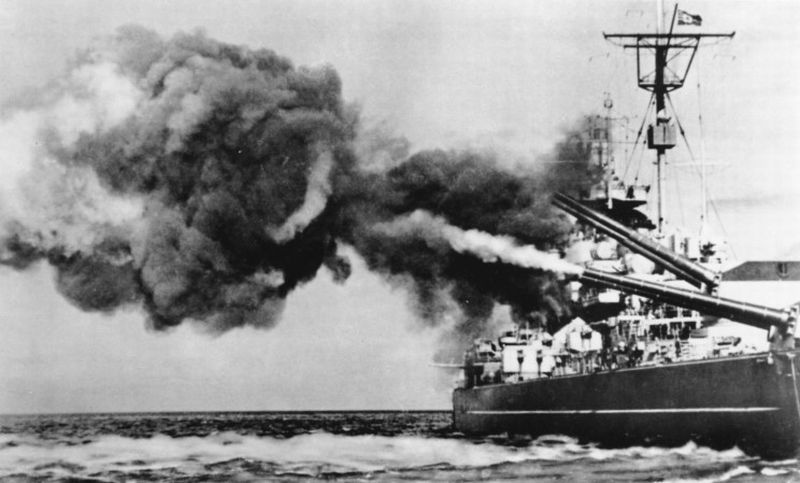 Tirpitz firing her main armament Source: Courtesy of Michael W. Pocock.
Tirpitz firing her main armament Source: Courtesy of Michael W. Pocock.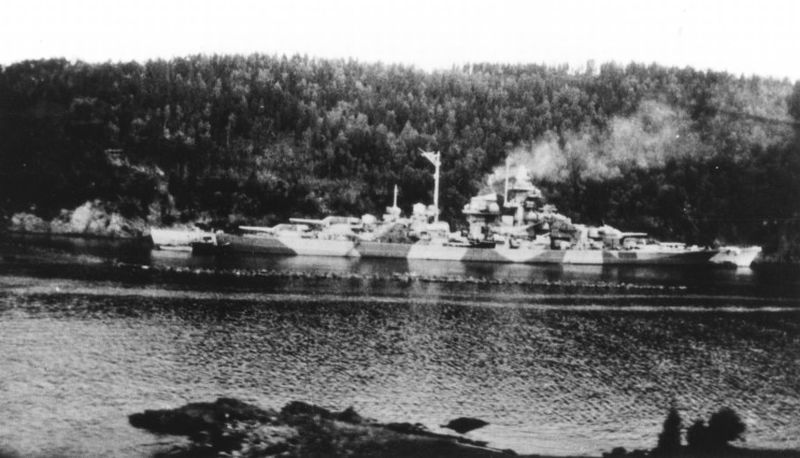 Tirpitz in the Fjaettenfjord near Trondheim in 1942 Source: Courtesy of Michael W. Pocock.
Tirpitz in the Fjaettenfjord near Trondheim in 1942 Source: Courtesy of Michael W. Pocock.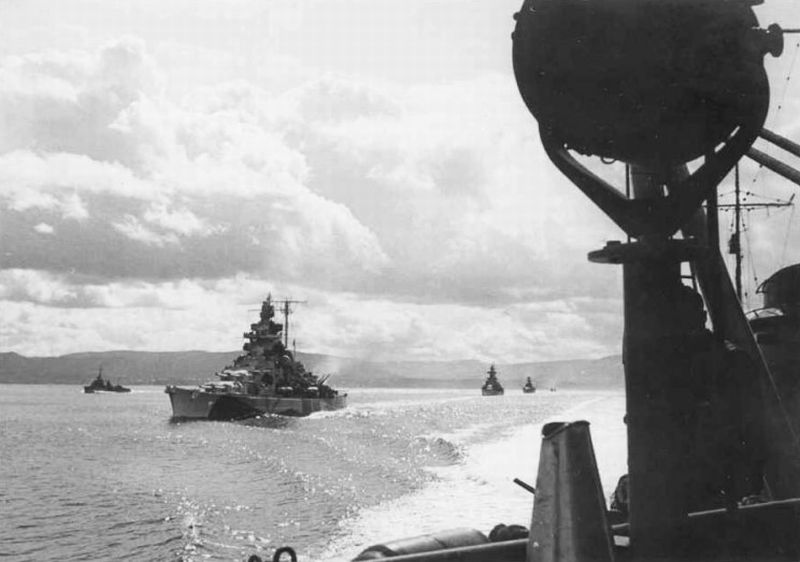 Tirpitz and Admiral Hipper at sea for Operation Rösselsprung, July 1942 Source: Courtesy of Michael W. Pocock.
Tirpitz and Admiral Hipper at sea for Operation Rösselsprung, July 1942 Source: Courtesy of Michael W. Pocock.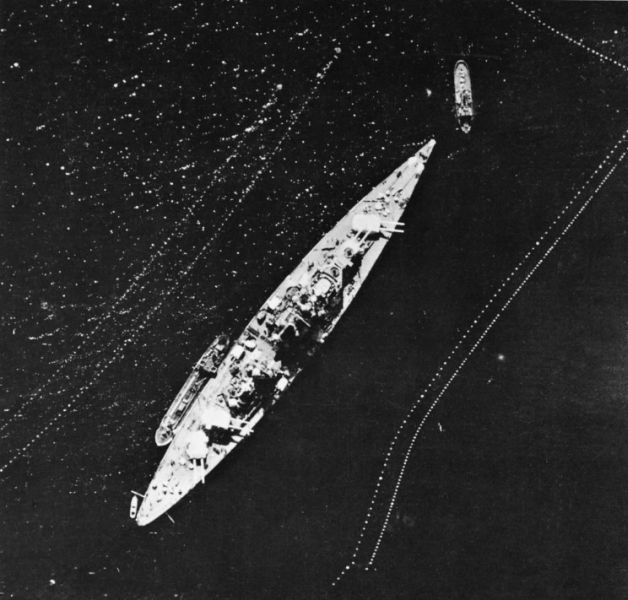 Tirpitz behind torpedo nets in Bogen near Narvik, July 1942 Source: Courtesy of Michael W. Pocock.
Tirpitz behind torpedo nets in Bogen near Narvik, July 1942 Source: Courtesy of Michael W. Pocock.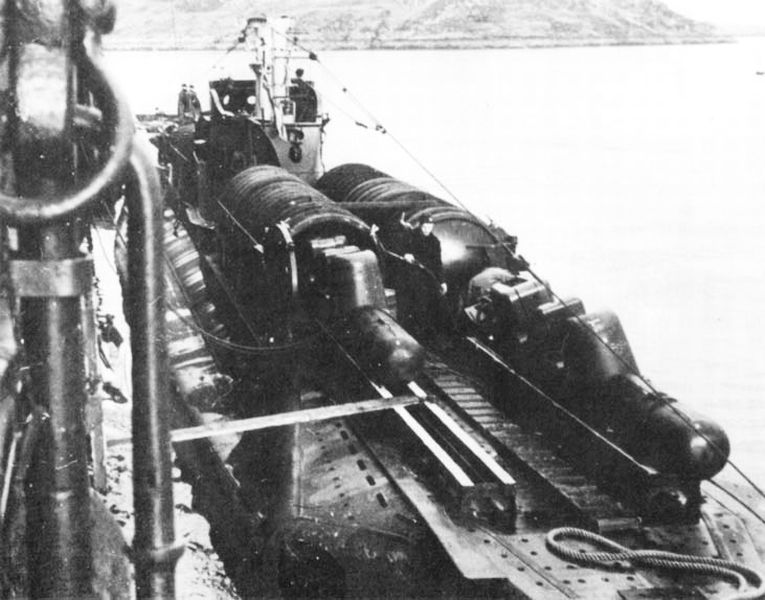 Chariots aboard a British submarine Source: Bismark-class.
Chariots aboard a British submarine Source: Bismark-class.The Lonely Queen of the North
On February 26, 1943 the battleship Scharnhorst arrived to reinforce the German battle fleet in Norway. Vice-admiral Oskar Kummetz took command of the fleet. After the heavy losses suffered by convoy PQ-17, the Allies had suspended the convoys to the Soviet Union. Großadmiral Karl Dönitz, who had succeeded Erich Raeder as Oberbefehlshaber der Kriegsmarine, had the German war ships perform exercises from the Kâfjord, a tributary of the Altafjord near Alta in the extreme north of Norway. Between September 6 and 9 the German war ships launched an attack on Spitsbergen in connection with Operation Sizilien. German troops came ashore on the main island where the British had a weather station and a refueling facility for ships. The German troops, tasked with the destruction of the enemy installations, were covered by the Tirpitz and Scharnhorst, they in turn were protected by 10 destroyers. Tirpitz fired 52 38cm rounds and 82 15cm rounds at the British positions. This was the first and at the same time the one but last occasion on which Tirpitz deployed her main armament against enemy targets. After the raid, the German vessels returned to Norwegian ports and Tirpitz berthed in the Altafjord.
The British could not ignore the threat of Tirpitz and launched Operation Source between September 20 and 22. This was an attack by 10 X-craft midget submarines, each equipped with two mines of 2,200 lbs each, on the German battleships Scharnhorst, Tirpitz and Lützow in the Altafjord. From September 11 onwards, the midgets were towed to Norway by T and S-class submarines. Only 3 of the X-craft, X-5, X-6 and X-7 managed to get through the torpedo barrier surrounding the Tirpitz. The other midgets were either lost or had to return empty-handed. X-5 was spotted by lookouts on the Tirpitz at a distance of 200 yards and sunk by gunfire and depth charges. X-6 and X-7 did succeed in placing their charges beneath the German battleship but X-6 was spotted and scuttled by her own crew. The 4 crewmembers were picked up by a lifeboat and taken aboard the Tirpitz.
Only 2 out of the 4 crewmembers managed to escape from the midget and they were also arrested by the Germans.Commander Meyer did not have the time to make up enough steam and escape but by using her anchors and mooring wires, she turned to starboard away from the side where X-6 had been spotted last. To no avail however as at 08:12 2 massive explosions lifted the battleship almost 3 feet out of the water. An oil tank was ruptured and armor plates buckled. A hole was blown in the double bottom of the vessel and over 1,400 tonnes of water rushed in, causing all turbo generators in generator room 2 to break down and only one in No. 1 generator room continued functioning. This caused almost all electric power to fail. The aft 38cm turret was lifted from its bearings and 2 of the 4 Arado spotter planes were blown overboard and utterly destroyed. A large number of frame beams was dislodged and the vessel listed 30 degrees to port. It would take almost 6 months before the battleship was repaired. Operation Source was the first attempt by the British to knock out the Tirpitz which was partly successful. The 6 crewmembers of X-6 and X-7 who had been arrested safely returned to Great Britain after the war.
On December 26, 1943, the Scharnhorst was lost during the battle of the North Cape. The Lützow and the destroyers were recalled to Germany to be deployed elsewhere. Tirpitz, with the maintenance vessel Neumark moored alongside, remained in the Altafjord. In the night of February 10 to 11, 1944 the German battleship was attacked by 15 Soviet bombers which could only score one near miss that did not any damage worth speaking of. At the end of March, all repairs to the Tirpitz were completed. Without heavy cranes or a dry dock, the German technicians had managed to restore the battleship to an acceptable level. In the middle of winter and far beyond the Arctic circle, this was an exceptional achievement. The British however soon noticed the departure of the Neumark and assumed correctly that repairs on the Lonely Queen of the North, as the Norwegians called her meanwhile, were completed. Without waiting any longer, they prepared for the next attack.
Operation Tungsten was launched on April 3, 1944. Tirpitz had completed a few sea trials and was at anchor again in the Altafjord. The Royal Navy attacked Tirpitz with 42 Fairey Barracuda dive bombers, escorted by 21 Vought Corsairs, 20 Grumman Hellcats and 10 Grumman Wildcat fighters. The aircraft had taken off from the carriers H.M.S. Victorious, H.M.S. Furious and the auxiliary carriers H.M.S. Emperor, H.M.S. Fencer, H.M.S. Pursuer and H.M.S. Searcher. The bombers scored 14 hits and a near miss with bombs of 1.600 and 500 lbs. Losses aboard the Tirpitz amounted to 122 dead and 316 injured. Two 15cm turrets were destroyed, and the two remaining spotter planes burned to ashes in their storage spaces. 2,000 tons of water leaked through buckled frame beams but her decks had not been penetrated and the vessel was still operational. Karl Dönitz ordered the Tirpitz to be repaired again as he needed the vessel as a threat to the Arctic convoys which had been resumed by the Allies.
On April 24, 1944, Operation Planet was to be launched but the British attack with 40 Fairey Barracudas and 40 escorting fighters had to be canceled due to bad weather. This scenario repeated itself in Operation Brawn, involving 27 Barracudas and 36 fighters. On May 28, weather conditions were so bad, the airplanes could not even take off from the carriers, causing Operation Tiger Claw to be aborted. That same month, Kapitän-zur-See Wolf Junge was named the new commander of the German battleship. The Royal Navy made yet another effort on July 17 to knock out the Tirpitz in an air raid. 44 Fairey Barracudas, 18 Vought Corsairs, 12 Fairey Fireflies and 18 Grumman Hellcats were involved in Operation Mascot, taking off from H.M.S. Formidable, H.M.S. Indefatigable and H.M.S. Furious. Tirpitz' crew however was aware of the attack because of the enhanced Funkmess Ortung (FuMO) 26 radar equipment and laid thick smokescreens causing the attack to fail. On July 31 and August 1, 1944, Tirpitz and 5 destroyers went through exercises on the northern Arctic Sea. It was to be her last exercise.
Definitielijst
- battleship
- Heavily armoured warship with very heavy artillery.
- Kriegsmarine
- Germa navy. Part of the Wehrmacht next to Heer and Luftwaffe.
- radar
- English abbreviation meaning: Radio Detection And Ranging. System to detect the presence, distance, speed and direction of an object, such as ships and airplanes, using electromagnetic waves.
- raid
- Fast military raid in enemy territory
- Soviet Union
- Soviet Russia, alternative name for the USSR.
- torpedo
- A weapon of war. A cigar shaped body fitted with explosives and a propulsion and control mechanism. Intended to target after launch a nearby enemy ship and disable it by underwater explosion.
Images
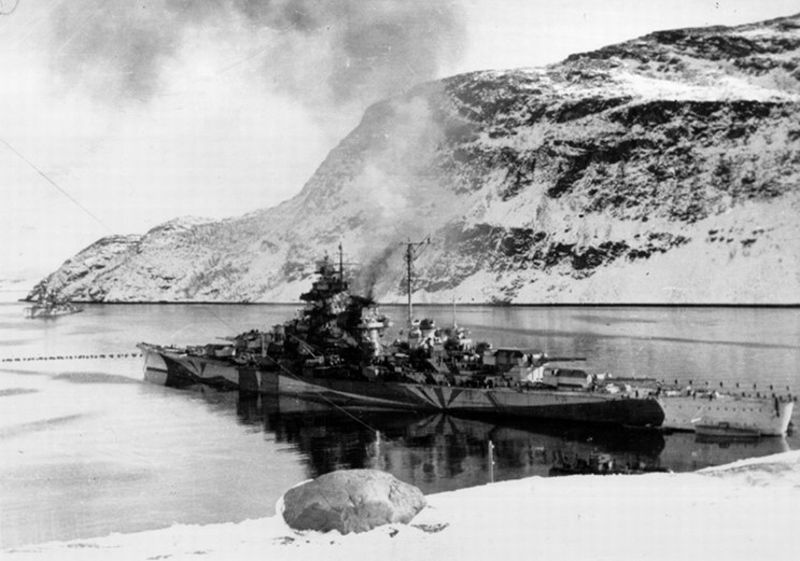 The Lonely Queen of the North in the Altafjord, March 1943 Source: Courtesy of Michael W. Pocock.
The Lonely Queen of the North in the Altafjord, March 1943 Source: Courtesy of Michael W. Pocock.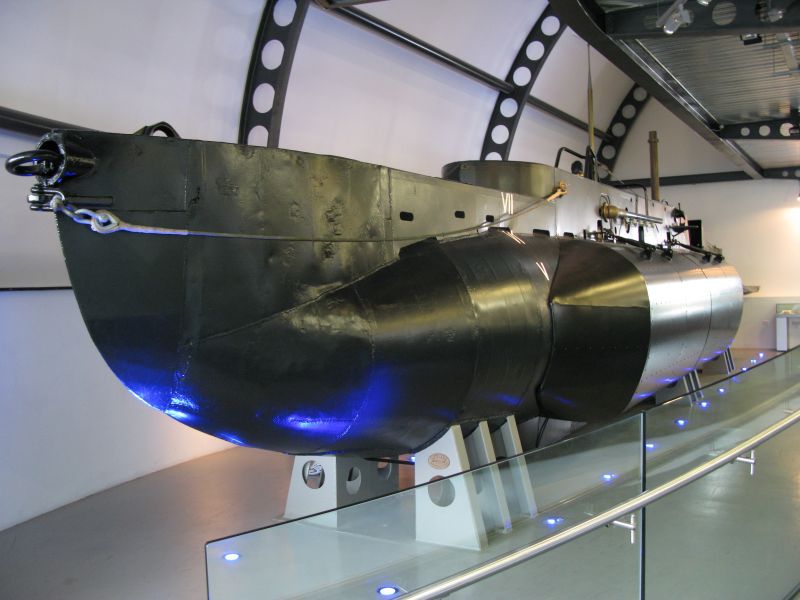 An X-craft midget submarine in the Submarine Museum in Gosport, southern UK Source: Geni_GFDL CC-BY-SA.
An X-craft midget submarine in the Submarine Museum in Gosport, southern UK Source: Geni_GFDL CC-BY-SA.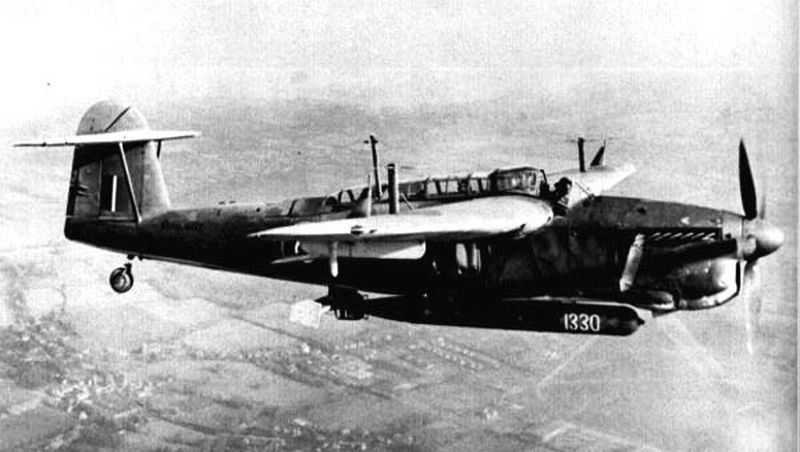 The Fairey Barracuda bomber was deployed against the Tirpitz by the Royal Navy Source: Wikimedia.
The Fairey Barracuda bomber was deployed against the Tirpitz by the Royal Navy Source: Wikimedia.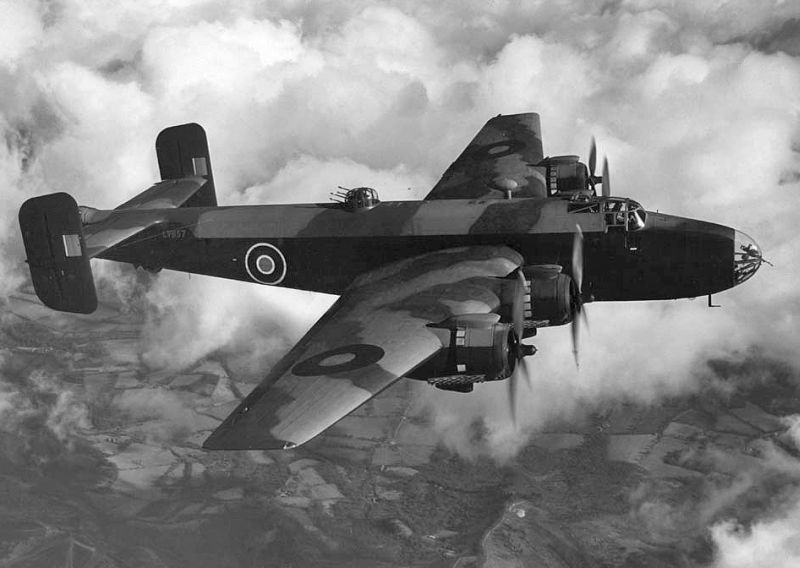 The Handley Page Halifax bomber was deployed against the Tirpitz by the R.A.F. Source: Wikimedia.
The Handley Page Halifax bomber was deployed against the Tirpitz by the R.A.F. Source: Wikimedia.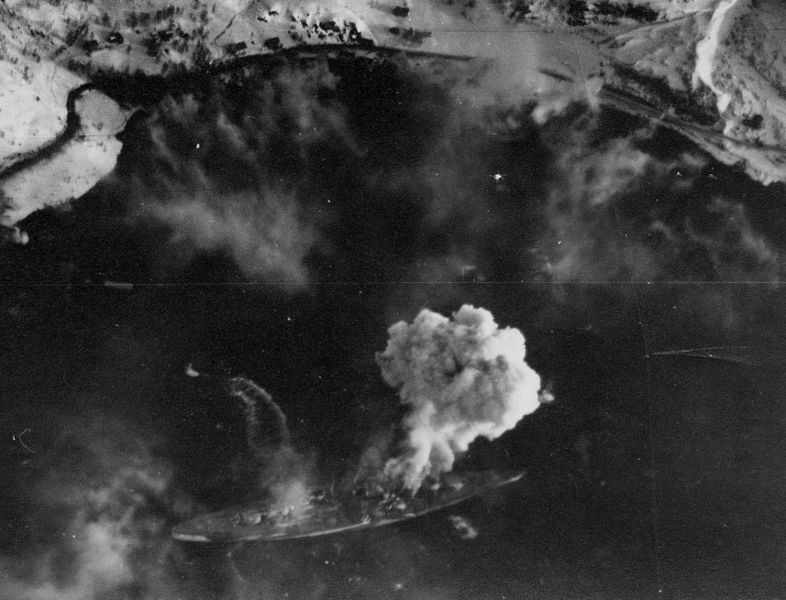 Tirpitz is struck by bombs in Operation Tungsten Source: Courtesy of Michael W. Pocock.
Tirpitz is struck by bombs in Operation Tungsten Source: Courtesy of Michael W. Pocock.The end of the Tirpitz
In August 1944, the Royal Navy made the last attempts to knock out the Tirpitz in Operation Goodwood I, II, III and IV. These air raids were carried out by Fairey Barracudas and escorting fighters from the carriers H.M.S. Formidable, H.M.S. Indefatigable, H.M.S. Furious and the auxiliary carriers H.M.S. Trumpeter and H.M.S. Nabob. During these 4 separate attacks the aircraft of the Royal Navy only scored 2 hits and a small number of near misses. The R.A.F. took over the attacks on the German battleship as the British carriers were badly needed elsewhere to protect troop transports in particular.
The R.A.F. had already drafted plans to attack the German battle ship with so-called Tallboys bombs. These were 12,000 lbs bombs designed by British scientist and inventor Barnes Wallis. The Tallboys were streamlined and fitted with tail fins which enabled the bombs, once they were dropped, to accelerate to very high speeds so they could penetrate not only 100 feet into the ground but also through armored steel decks. Operation Paravane was carried out by AVRO Lancaster of No. 9 and No. 617 Squadrons of No. 5 Group R.A.F. Bomber Command. No. 617 Squadron was known as the Dam Busters as they had bombed dams in the Ruhr area on May 17, 1943, Operation Chastise by dropping special bouncing bombs using the Stabilizing Automatic Bomb Sight, a state of the art aiming mechanism installed in the British heavy four-engine bombers. Altafjord was out of reach for the 38 Lancasters in Operation Paravane from their bases on the British isles, therefore, on September 11, 1944 they first flew from their base R.A.F. Lossiemouth, Scotland to Yagodnik near Archangelsk in northwestern Russia. Because of the low clouds, a number of Lancasters could not find the base and although their crews were rescued by the Russians, 6 aircraft remained behind in the moors around the base.
On September 15, 28 Lancasters, of which 20 were carrying a single Tallboy, 7 carried mines against shipping in shallow water whilst the last aircraft was fitted with photographic equipment, took off from the Russian base. The British aircraft were spotted again by the tracking equipment aboard the Tirpitz and were welcomed with a thick smokescreen and a hail of anti-aircraft bullets. Hence the British were only able to score 2 hits on the forecastle of the Tirpitz. However, the Tallboys inflicted so much damage to the Tirpitz, she could never be made seaworthy again without having to be put in dry dock for a considerable period of time. The heavy bombs had slammed right through the stem of the German battleship and had exploded on the bottom of the fjord. The ensuing shock wave had caused massive damage to her engines, gunnery control systems and the beams of the vessel. The Germans decided to move the battleship to the small island of Hâkøy near Tromsø to serve as a floating artillery emplacement against the expected Allied invasion of Norway. On October 15, Tirpitz made her final voyage, covering the 200 nautical miles to Tromsø at only 8 to 10 knots.
The leadership of the German navy was not aware of the fact that Tirpitz was now just within reach of Lancasters flying from Scotland. The Germans had begun to construct a sandbank beneath the Tirpitz which was to prevent her from capsizing or sinking in case of possible hits. Even before the bank was ready, R.A.F. Bomber Command launched Operation Obviate on October 29, 1944. For this attack, 39 Lancasters of the same squadrons that had been involved in Operation Paravane took off from bases in Scotland to bomb the Tirpitz with Tallboys once again. Owing to bad weather, the heavy bombs missed their targets and the only result of the operation was a near miss, causing damage to the port rudder and the port propeller shaft. Nonetheless, the German prepared the battleship for her role as artillery emplacement. The sandbank was raised and anti-torpedo nets were rigged around the Tirpitz. The amount of fuel was limited to the amount needed to fuel the turbo generators and the number of crew members was decreased to 1,600 men. Early November 1944, a new commander of the battleship was named: Kapitän-zur-See Robert Weber.
On November 12, 1944, R.A.F. Bomber Command launched Operation Catechism. Again, Lancasters of No. 617 and No. 9 Squadrons carrying Tallboys took off from bases in Scotland. At 09:35 the 31 four engine bombers were met by the 38cm shells of Tirpitz' main armament but the projectiles could not stop 29 Lancasters from dropping their super bombs. Two Tallboys scored direct hits and one near miss. Various others came down inside the torpedo nets and destroyed the better part of the bank beneath the battleship. One of the bombs struck the vessel between the two forward 38cm turrets but did not explode. The second direct hit exploded amidships between the catapult and the funnel, blowing huge holes in the bottom and the port hull. A large part of the belt armor in the direct vicinity of the impact was blown away. The near miss exploded on the port side of the vessel near C-turret, the forward of both aft 38cm turrets and caused even more damage to the hull. Tirpitz started listing to port which rapidly increased to 20 degrees. Commander Weber ordered the crew to abandon ship and towards 09:50 the list had increased to a dangerous 60 degrees. For a moment it looked like the vessel would stabilize itself in this position but 8 minutes later, a huge explosion sounded beneath C-turret. The armored roof of the turret was blown 82 feet away and landed in a group of swimming crewmembers. The battleship capsized and her superstructure disappeared into the remnants of the destroyed bank.
Right after the attack, rescue attempts were launched in order to free over 1,000 crew members, trapped inside the armored hull of the battleship. Technical specialists from the crew who had managed to escape, dock yard workers and other navy personnel managed to cut a few holes in her keel using blow torches and enabled 82 crewmembers to escape. For 971 others, rescue came too late because of the fast flowing water of the incoming tide.
Definitielijst
- battleship
- Heavily armoured warship with very heavy artillery.
- Bomber Command
- RAF unit which controlled strategic and sometimes tactical bombing (as in Normandy)
- Dam Busters
- Nickname for the group of pilots of 617 Squadron who attacked and destroyed some of the dams in the Ruhr valley in the night of 16-17 May 1943. Although this difficult and daring and attack was successful the damage to the German (war) effort was limited. Besides that a large number of foreign forced labourers and allied POW were killed. Eight out of 19 Lancasters were shot down. However the moral and propaganda value were quite high.
- invasion
- Armed incursion.
- Squadron
- A military unit in the Belgian navy usually six to eight small ships operating together under one command. The smallest military unit in the Dutch air force of about 350 men. In most countries is the designation of a military unit thesize of a company. It is either an independent unit, such as a battery, or part of a bigger Calvary unit. In the air force it is the designation of a unit of aircrafts.
- torpedo
- A weapon of war. A cigar shaped body fitted with explosives and a propulsion and control mechanism. Intended to target after launch a nearby enemy ship and disable it by underwater explosion.
Images
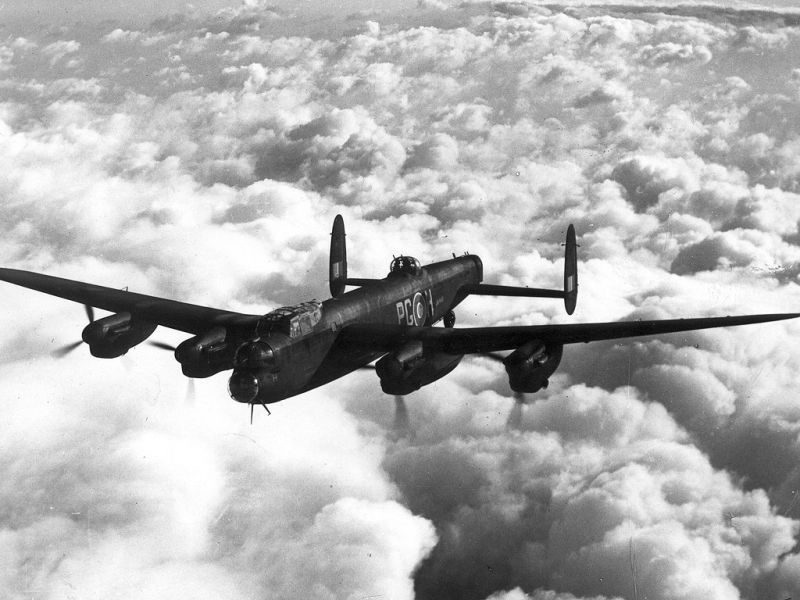 R.A.F. Lancasters eventually managed to knock out the Tirpitz Source: Wikimedia.
R.A.F. Lancasters eventually managed to knock out the Tirpitz Source: Wikimedia.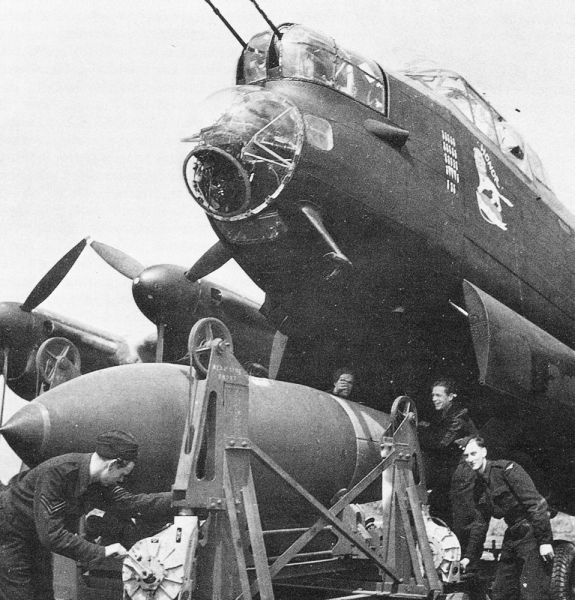 A Tallboy is being attached to an AVRO Lancaster Source: ww2total.
A Tallboy is being attached to an AVRO Lancaster Source: ww2total.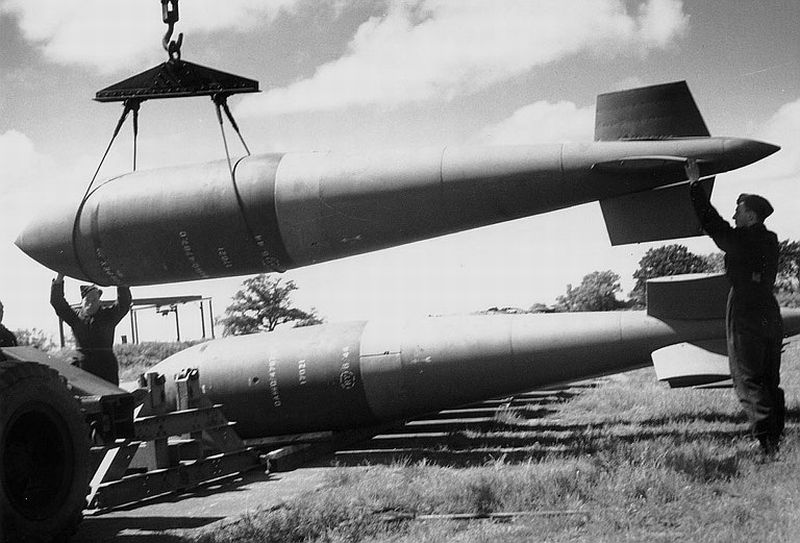 Ground handling Tallboy bombs by R.A.F. personnel Source: Ausairpower.
Ground handling Tallboy bombs by R.A.F. personnel Source: Ausairpower.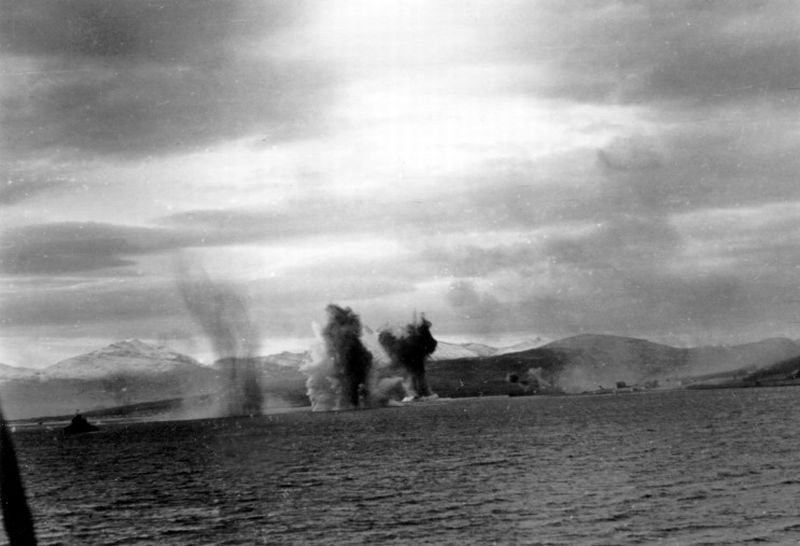 Operation Catechism, the aerial attack on Tirpitz, November 12, 1944 Source: Courtesy of Michael W. Pocock.
Operation Catechism, the aerial attack on Tirpitz, November 12, 1944 Source: Courtesy of Michael W. Pocock.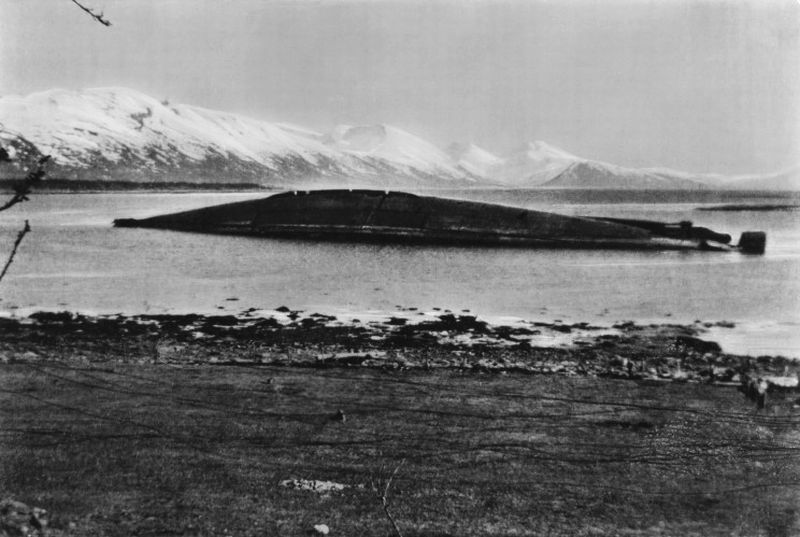 Tirpitz has capsized Source: Courtesy of Michael W. Pocock.
Tirpitz has capsized Source: Courtesy of Michael W. Pocock.Epilogue
As Winston Churchill had already given high priority to the destruction of the Tirpitz and due to the perseverance of the British, the death sentence of the German battleship had already been pronounced in 1942. Due a combination of camouflage, anti-aircraft defenses, torpedo nets and smokescreens, bad weather and the fact that the battleship lay hidden in a distant location, it took over 2 years before the German battleship was permanently knocked out. Throughout that period, the battleship posed a serious threat, forcing the Allies to protect their convoys with battleships, carriers and cruisers instead of escorts and destroyers. The presence of Tirpitz in Norway was sufficient to nail down many Allied capital vessels and keep them away from other theatres. The Lonely Queen of the North proved to be the ultimate Fleet in Being.
After the war, the Norwegian government sold the wreck of the Tirpitz to the Norwegian firm of Einar Høvding Skippsuphuggging (marine salvage company) for 120,000 Kroner. This was a very low price for a wreck from which so many valuable parts and material could be salvaged. For instance, the turbo generators were sold to a fish processing factory in the Norwegian Honnigsvag where they provided electric power to the factories for years. Furthermore, many steel plates from the wreck were used as temporary road pavement during road construction work in Norway and the company made a lot of money with the large amounts of copper, stainless steel and other metals. Dismantling the wreck lasted from 1948 to 1957. Today, only some flooded craters made by stray Tallboys, some rusty parts rising out of the water and a small monument on the island of Håkøy are silent reminders of the largest battleship of World War Two in Europe.
Definitielijst
- battleship
- Heavily armoured warship with very heavy artillery.
- Fleet in Being
- A war fleet preventing battle but by its presence and force forcing the enemy to take measures by allocating forces to keep an eye on them thus preventing those forces from being deployed elsewhere.
- torpedo
- A weapon of war. A cigar shaped body fitted with explosives and a propulsion and control mechanism. Intended to target after launch a nearby enemy ship and disable it by underwater explosion.
Images
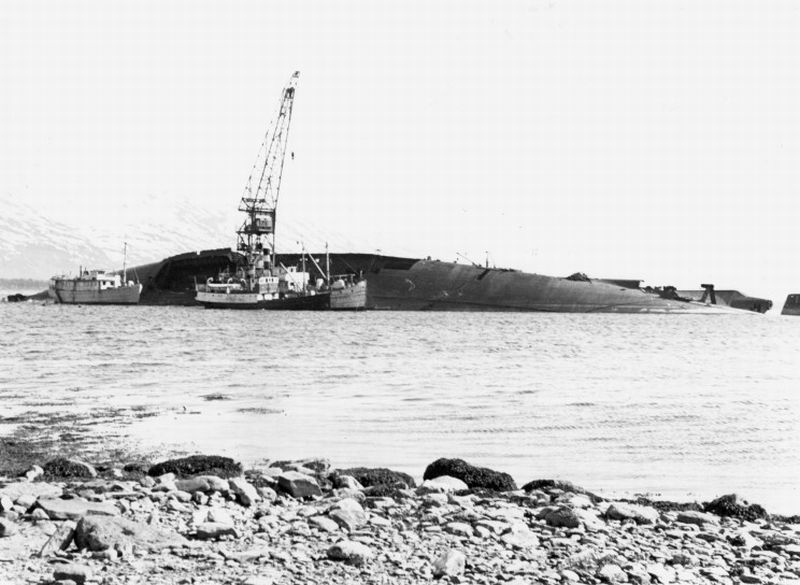 Dismantling the Tirpitz would take until 1957 Source: Courtesy of Michael W. Pocock.
Dismantling the Tirpitz would take until 1957 Source: Courtesy of Michael W. Pocock.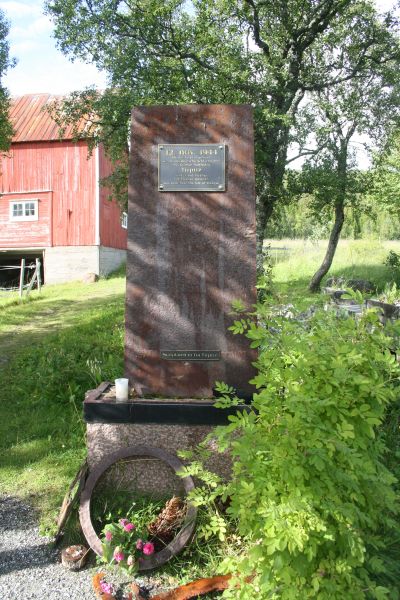 The Tirpitz memorial on Håkøy Source: Wikimedia.
The Tirpitz memorial on Håkøy Source: Wikimedia.Information
- Article by:
- Peter Kimenai
- Translated by:
- Arnold Palthe
- Published on:
- 05-07-2019
- Last edit on:
- 30-09-2024
- Feedback?
- Send it!
Related sights
Related books
Sources
- HORE, P, Slagschepen, Veltman Uitgevers, Utrecht, 2006.
- HUMBLE, R., Duitse Kriegsmarine, Standaard Uitgeverij, Antwerpen, 1991.
- MALLMANN-SHOWELL J.P., Das buch der deutschen kriegsmarine 1935-1945, Motorbuch verlag, Stuttgart, 1995.
- STERN, R.C., Kriegsmarine, Arms & Armour Press, London-Melbourne, 1979.
